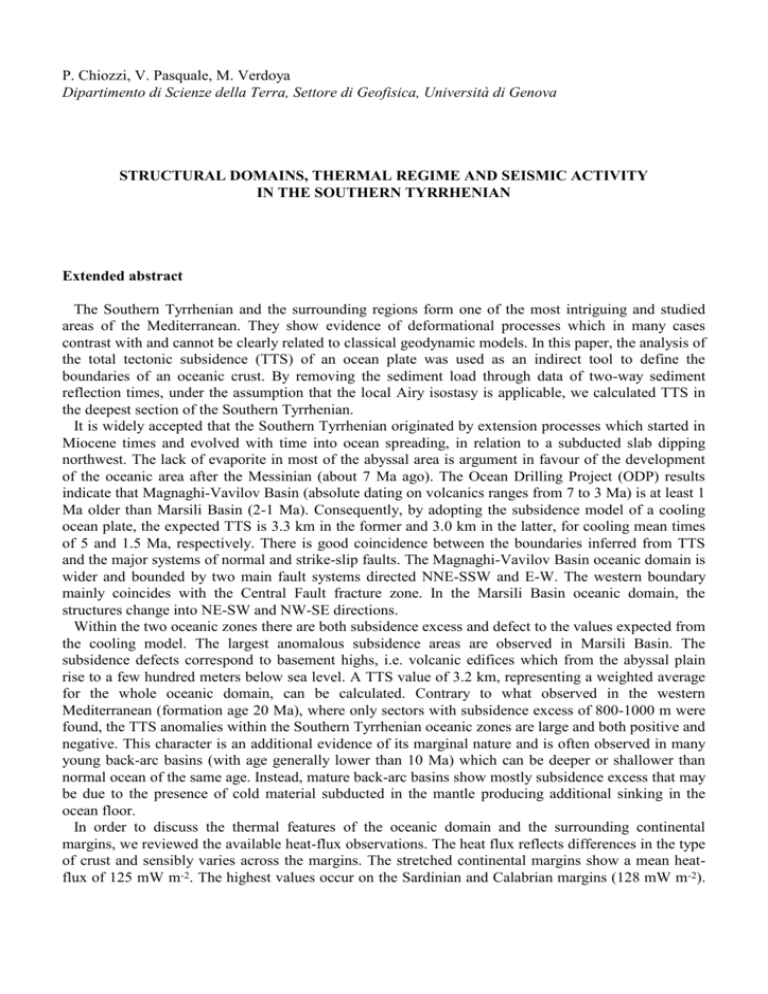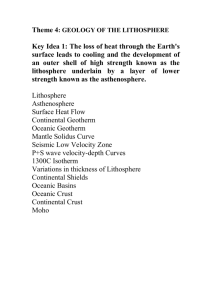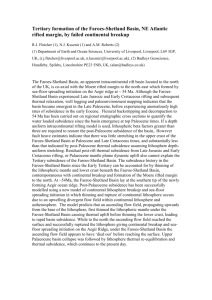Riassunto esteso Roma 1997
advertisement

P. Chiozzi, V. Pasquale, M. Verdoya Dipartimento di Scienze della Terra, Settore di Geofisica, Università di Genova STRUCTURAL DOMAINS, THERMAL REGIME AND SEISMIC ACTIVITY IN THE SOUTHERN TYRRHENIAN Extended abstract The Southern Tyrrhenian and the surrounding regions form one of the most intriguing and studied areas of the Mediterranean. They show evidence of deformational processes which in many cases contrast with and cannot be clearly related to classical geodynamic models. In this paper, the analysis of the total tectonic subsidence (TTS) of an ocean plate was used as an indirect tool to define the boundaries of an oceanic crust. By removing the sediment load through data of two-way sediment reflection times, under the assumption that the local Airy isostasy is applicable, we calculated TTS in the deepest section of the Southern Tyrrhenian. It is widely accepted that the Southern Tyrrhenian originated by extension processes which started in Miocene times and evolved with time into ocean spreading, in relation to a subducted slab dipping northwest. The lack of evaporite in most of the abyssal area is argument in favour of the development of the oceanic area after the Messinian (about 7 Ma ago). The Ocean Drilling Project (ODP) results indicate that Magnaghi-Vavilov Basin (absolute dating on volcanics ranges from 7 to 3 Ma) is at least 1 Ma older than Marsili Basin (2-1 Ma). Consequently, by adopting the subsidence model of a cooling ocean plate, the expected TTS is 3.3 km in the former and 3.0 km in the latter, for cooling mean times of 5 and 1.5 Ma, respectively. There is good coincidence between the boundaries inferred from TTS and the major systems of normal and strike-slip faults. The Magnaghi-Vavilov Basin oceanic domain is wider and bounded by two main fault systems directed NNE-SSW and E-W. The western boundary mainly coincides with the Central Fault fracture zone. In the Marsili Basin oceanic domain, the structures change into NE-SW and NW-SE directions. Within the two oceanic zones there are both subsidence excess and defect to the values expected from the cooling model. The largest anomalous subsidence areas are observed in Marsili Basin. The subsidence defects correspond to basement highs, i.e. volcanic edifices which from the abyssal plain rise to a few hundred meters below sea level. A TTS value of 3.2 km, representing a weighted average for the whole oceanic domain, can be calculated. Contrary to what observed in the western Mediterranean (formation age 20 Ma), where only sectors with subsidence excess of 800-1000 m were found, the TTS anomalies within the Southern Tyrrhenian oceanic zones are large and both positive and negative. This character is an additional evidence of its marginal nature and is often observed in many young back-arc basins (with age generally lower than 10 Ma) which can be deeper or shallower than normal ocean of the same age. Instead, mature back-arc basins show mostly subsidence excess that may be due to the presence of cold material subducted in the mantle producing additional sinking in the ocean floor. In order to discuss the thermal features of the oceanic domain and the surrounding continental margins, we reviewed the available heat-flux observations. The heat flux reflects differences in the type of crust and sensibly varies across the margins. The stretched continental margins show a mean heatflux of 125 mW m-2. The highest values occur on the Sardinian and Calabrian margins (128 mW m-2). The average heat-flux in the oceanic domain is 161 mW m-2 and it varies from 157 in MagnaghiVavilov Basin to 171 mW m-2 in Marsili Basin. In order to study the thermal history of the Southern Tyrrhenian, we applied the uniform extension model for the continental margins and cooling plate models for the oceanic domain. The average surface heat flux on the continental margins, that stretched 7-11 Ma ago, indicates a thinning factor, i.e. the ratio of pre-rift crustal thickness on present-day thickness, between 3.5 and 4. The agreement with the ocean-floor cooling curves is, instead, very poor, as the average surface heat-flux of the oceanic domains is decidedly lower than that expected. In this case, a purely conductive heat transfer is probably not applicable, and the observed values represent minimum estimates of the true heat flux. A convective heat loss of 90-110 mW m-2 through hydrothermal circulation within the ocean crust is likely to occur as the theoretically predicted surface heat flux should be 250-270 mW m-2 for an average age of 3.5 Ma. Above structural highs, such as seamounts, the absence of thick impermeable sediment might cause cooling by water penetration and circulation. On the other hand, in areas where the sedimentary cover is sufficient to ensure insulation from the underlying formations, the heat flux in excess to the expected value (up to 325 mW m-2) are essentially related to non-conductive processes at shallow depth. Earthquakes with mb>4 and spanning from 1970 to 1994 were analysed. Focal depths increase towards the northeast, and reach the maximum depth of about 500 km beneath the central part of the oceanised abyssal area. The seismic activity shows the maximum frequency of events in the depth interval 200-350 km and in terms of energy (magnitude) is maximum between 250 and 300 km. Most earthquakes are confined within a 30-50 km thick zone. The slab dips at an angle of about 65 from 100 to 400 km which decreases down to the depth at which the deepest event occurred. The focal mechanism of the deep and intermediate earthquakes is similar to that of the shallower ones. Several analyses show that the focal mechanisms are by predominant down-dip compression. Similar stress patterns were observed in subducting zones of the Pacific area which, however, show also isolated large mantle earthquakes outside the main Wadati-Benioff zone. It is widely accepted that the deep seismic activity within a subducted slab is controlled by a critical temperature below which the deformation of the lithosphere is accompanied by seismic activity. This is probably caused by the dependence of the creep of materials on the ratio of their temperature to the melting temperature. From precise depth determinations of world-wide earthquakes associated with a bending oceanic lithosphere, it was estimated that the ratio of the depth-dependent critical temperature on the melting temperature, referred to the composite mantle solidus, is equal to 0.54. Our analysis of the thermomechanical properties of the Southern Tyrrhenian slab is based on such an approach. The minimum value of the temperature as a function of depth within a slab sinking through the mantle with adiabatic temperature gradient was evaluated by means of the analytical approach. The adiabatic temperature distribution in the upper mantle below the lithosphere corresponds to a constant potential temperature of 1200 C. The latent heat of the olivine-spinel phase change, resulting in a temperature increase by 135 C, was taken into account. Calculations were made under different hypotheses of velocity and thickness of the descending lithosphere. All solutions in which the difference between the minimum predicted temperature and the critical temperature is negative account for a sismogenetic zone within the slab. The velocity at which the lithosphere sinks is therefore a critical parameter. By adopting a subduction rate of 6 10-2 m/yr, a slab with thickness of 60-70 km could yield rheological conditions which justify the observed seismic activity. Information on the mechanical effect of subduction is supplied by the correlation between subsidence and the dip angle of the subducted slab. The Southern Tyrrhenian oceanic basement average depth was compared with some young basins of the Pacific area, all characterised by large depth variations. As the dipping angle increases, the basin becomes deeper. The Southern Tyrrhenian dip angle well fits the general trend. The correlation between the depth of the oceanic domain and the dip angle seems to be consistent with the mechanism accounting for the very shallow water depth of the axial zone of backarc basins during their rifting period as possibly due to buoyancy of hot mass accumulated on a rigid subducting slab. Therefore, back-arc basins follow a subsidence curve which is initially steeper than mature ocean crust. There is evidence from ODP data that basalt and oldest sediment in Marsili Basin were initially emplaced at anomalously shallow depth (less than 2500 m) and then subsided at a very fast rate. Moreover, the increase of the ocean basement depth with the dip angle of the associated slab could be connected with the drag stress in the vicinity of the downgoing lithosphere. Lavoro inviato per la pubblicazione alla rivista "Tectonophysics"








